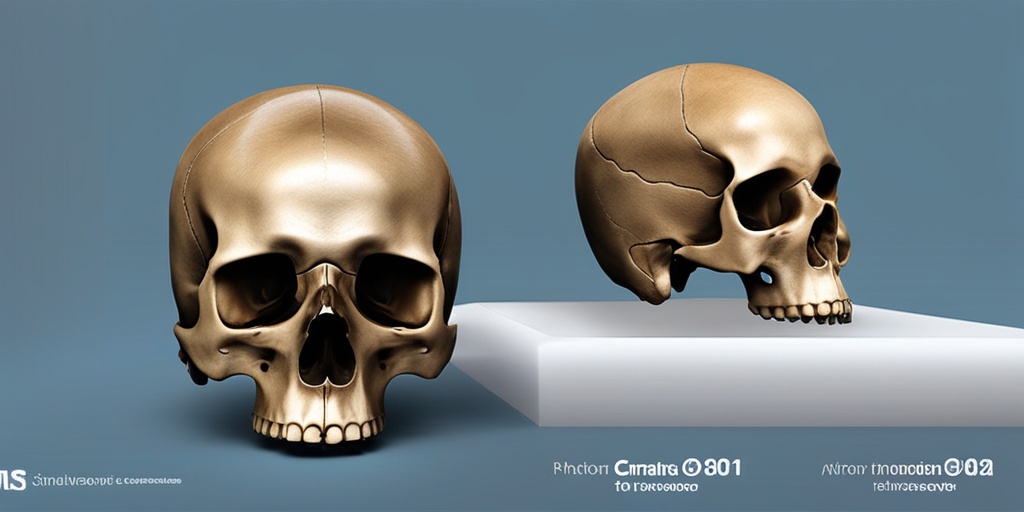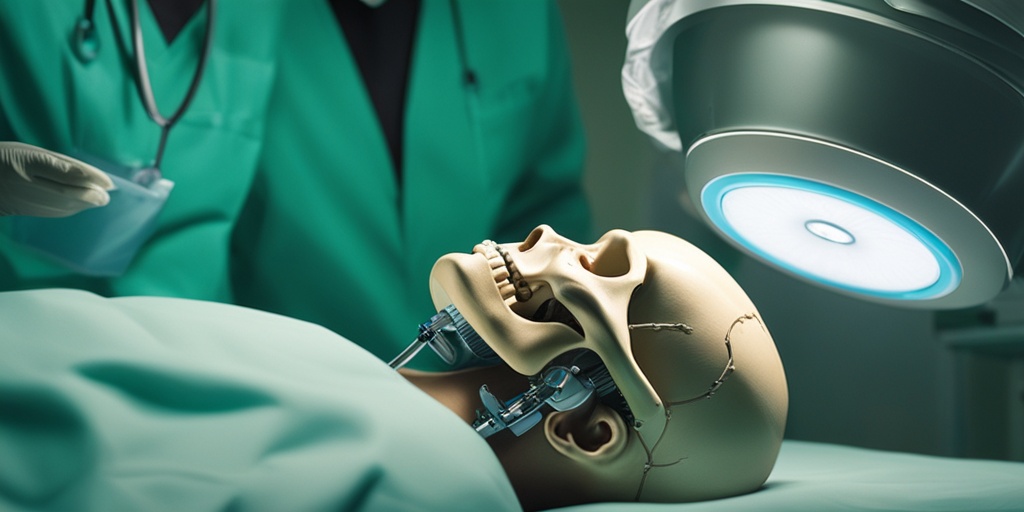What Is Syndactylic Oxycephaly?
Syndactylic oxycephaly is a rare congenital condition that affects the development of the skull and fingers. It’s a complex term that might be unfamiliar to many, but understanding what it means can help you better appreciate the intricacies of human development. So, let’s break it down!
What does “Syndactylic” mean?
The term “syndactylic” refers to a condition where two or more fingers are fused or connected together. This can occur in various ways, such as webbed fingers or fingers that are completely joined together. Syndactyly is a relatively common congenital anomaly, affecting about 1 in every 2,000 to 3,000 births.
What about “Oxycephaly”?
Oxycephaly, on the other hand, is a rare condition where the bones of the skull fuse together prematurely, resulting in an abnormally shaped head. This can lead to a range of complications, including increased pressure on the brain, vision problems, and even developmental delays.
Putting it together: Syndactylic Oxycephaly
When we combine these two conditions, we get syndactylic oxycephaly – a rare and complex condition where the fingers are fused together, and the bones of the skull are prematurely fused, leading to an abnormal head shape. This condition is extremely rare, with only a handful of reported cases worldwide.
Understanding Craniosynostosis
Syndactylic oxycephaly is closely related to craniosynostosis, a condition where the bones of the skull fuse together prematurely. Craniosynostosis can occur in various forms, including oxycephaly, and can have a significant impact on a child’s development and quality of life.
What causes Craniosynostosis?
The exact causes of craniosynostosis are still not fully understood, but it’s believed to be related to a combination of genetic and environmental factors. In some cases, it may be associated with certain genetic syndromes or chromosomal abnormalities.
Symptoms and Complications
Craniosynostosis can lead to a range of symptoms, including:
- Abnormal head shape
- Increased pressure on the brain
- Vision problems
- Developmental delays
- Seizures
- Hearing loss
If left untreated, craniosynostosis can lead to serious complications, including brain damage, vision loss, and even death. Early diagnosis and treatment are crucial to preventing these complications and ensuring the best possible outcomes for affected children.
At Yesil Health AI (yesilhealth.com), we understand the importance of evidence-based health answers. Our AI-powered platform provides accurate and reliable information on a range of health topics, including rare conditions like syndactylic oxycephaly and craniosynostosis. 💡
By shedding light on these complex conditions, we hope to raise awareness and support for affected families, as well as encourage further research into the causes and treatments of these rare and fascinating conditions. 🌟

Syndactylic Oxycephaly Symptoms
Syndactylic oxycephaly is a rare genetic disorder that affects the development of the skull and limbs. It’s essential to recognize the symptoms early on to provide proper treatment and care. Here are some common symptoms associated with syndactylic oxycephaly:
Physical Characteristics
Individuals with syndactylic oxycephaly often have distinct physical features, including:
- Fused fingers and toes: This is the most prominent symptom, where two or more fingers or toes are joined together.
- Abnormal head shape: The skull may be misshapen, with a pointed top and a narrow forehead.
- Small stature: People with syndactylic oxycephaly may have short stature or growth delays.
- Facial abnormalities: Some individuals may have a small jaw, a prominent nose, or other facial deformities.
Neurological Symptoms
In addition to physical characteristics, syndactylic oxycephaly can also affect the nervous system, leading to:
- Developmental delays: Children with syndactylic oxycephaly may experience delays in reaching milestones, such as sitting, standing, or walking.
- Intellectual disability: Some individuals may have intellectual disabilities or learning difficulties.
- Seizures: In some cases, people with syndactylic oxycephaly may experience seizures, which can be managed with medication.
Other Symptoms
Other symptoms of syndactylic oxycephaly may include:
- Vision problems: Some individuals may have vision impairments or blindness.
- Hearing loss: Hearing difficulties or deafness can occur in people with syndactylic oxycephaly.
- Respiratory issues: Breathing difficulties or respiratory infections may be more common in individuals with this condition.
It’s essential to note that each person with syndactylic oxycephaly is unique, and not everyone will exhibit all of these symptoms. If you suspect someone has this condition, consult a healthcare professional for an accurate diagnosis and treatment plan. 🏥
Syndactylic Oxycephaly Causes and Risk Factors
Syndactylic oxycephaly is a genetic disorder, which means it’s caused by mutations in one or more genes. While the exact causes are still not fully understood, research has identified some risk factors and genetic mutations associated with this condition.
Genetic Mutations
Syndactylic oxycephaly is often linked to mutations in the following genes:
- FGFR1: Mutations in this gene can affect the development of the skull and limbs.
- FGFR2: This gene is involved in the formation of bones and cartilage.
- FGFR3: Mutations in this gene can lead to abnormalities in bone growth and development.
Risk Factors
Certain factors can increase the risk of having a child with syndactylic oxycephaly:
- Family history: If there’s a family history of syndactylic oxycephaly or other genetic disorders, the risk of having an affected child may be higher.
- Advanced parental age: The risk of genetic mutations increases with the age of the parents, particularly the mother.
- Consanguinity: Marriage between close relatives can increase the risk of genetic disorders, including syndactylic oxycephaly.
While these risk factors can contribute to the development of syndactylic oxycephaly, it’s essential to remember that this condition is rare and can occur in anyone, regardless of their family history or genetic background. 💡

Diagnosing Syndactylic Oxycephaly
Syndactylic oxycephaly is a rare congenital disorder that affects the development of the skull and fingers. Diagnosing this condition can be a complex process, requiring a combination of physical examinations, medical imaging, and genetic testing. In this section, we’ll delve into the diagnostic process for syndactylic oxycephaly.
Physical Examination
The diagnosis of syndactylic oxycephaly often begins with a physical examination by a pediatrician or a geneticist. During this examination, the doctor will look for characteristic physical features, such as:
- Fusion of fingers or toes (syndactyly)
- Abnormal head shape, including a pointed or cone-shaped head (oxycephaly)
- Other craniofacial abnormalities, such as a prominent forehead, a small face, or a short nose
The doctor may also check for any other associated abnormalities, such as vision or hearing problems, developmental delays, or intellectual disability.
Medical Imaging
Medical imaging tests are essential for confirming the diagnosis of syndactylic oxycephaly. These tests may include:
- X-rays: To evaluate the bone structure of the skull and fingers
- CT scans: To provide detailed images of the brain and skull
- MRIs: To assess the brain structure and identify any associated abnormalities
- Ultrasound: To examine the fingers and toes for any abnormalities
These tests help doctors identify the extent of the condition and rule out other possible causes of the symptoms.
Genetic Testing
Syndactylic oxycephaly can be caused by genetic mutations, so genetic testing may be necessary to identify the underlying cause of the condition. This may involve:
- Chromosomal analysis: To identify any chromosomal abnormalities
- Gene sequencing: To identify specific genetic mutations
- Genetic counseling: To provide guidance on the risk of recurrence and the implications for family planning
Genetic testing can help doctors understand the underlying causes of the condition and provide a more accurate diagnosis.
Syndactylic Oxycephaly Treatment Options
Treatment for syndactylic oxycephaly typically involves a multidisciplinary approach, involving a team of healthcare professionals, including pediatricians, geneticists, orthopedic surgeons, and occupational therapists. The goal of treatment is to manage the symptoms, improve quality of life, and address any associated complications.
Surgical Interventions
Surgery may be necessary to correct physical abnormalities, such as:
- Separating fused fingers or toes to improve mobility and function
- Correcting craniofacial abnormalities, such as a pointed or cone-shaped head
- Addressing any associated skeletal abnormalities, such as clubfoot or scoliosis
Surgery can help improve the appearance and function of the affected limbs and skull.
Non-Surgical Interventions
In addition to surgery, non-surgical interventions may be necessary to manage the symptoms and improve quality of life. These may include:
- Occupational therapy: To improve fine motor skills and hand function
- Physical therapy: To improve mobility and strength
- Speech therapy: To address any communication difficulties
- Orthotics and prosthetics: To provide support and improve mobility
These interventions can help individuals with syndactylic oxycephaly adapt to their condition and achieve their full potential.
Remember, every individual with syndactylic oxycephaly is unique, and treatment plans should be tailored to their specific needs and circumstances. With the right treatment and support, individuals with this condition can lead fulfilling and meaningful lives 💕.

Surgical Interventions for Syndactylic Oxycephaly
Syndactylic oxycephaly is a rare congenital condition characterized by the fusion of fingers or toes, accompanied by a premature fusion of the cranial sutures. This complex condition requires a multidisciplinary approach to manage its various aspects. Surgical interventions play a crucial role in treating syndactylic oxycephaly, and in this section, we’ll delve into the different surgical options available.
Separation of Fused Digits
One of the primary goals of surgical intervention is to separate the fused digits, restoring functional independence to the affected fingers or toes. This procedure is typically performed during early childhood, between 1-3 years of age, to maximize the potential for normal development. The surgical approach involves releasing the connecting tissue between the fused digits, followed by reconstruction of the surrounding skin and soft tissue.
Cranial Vault Remodeling
Cranial vault remodeling is a complex surgical procedure aimed at reshaping the skull to improve its shape and size. This intervention is usually performed during the first year of life, as the skull is still malleable and can be molded into a more normal shape. The procedure involves removing and repositioning bone segments, followed by reconstruction of the scalp and soft tissue.
Other Surgical Interventions
In addition to digit separation and cranial vault remodeling, other surgical interventions may be necessary to address associated conditions, such as:
- Strabismus surgery: to correct eye muscle imbalance and improve vision
- Hearing aids or cochlear implants: to address hearing loss or impairment
- Orthodontic treatment: to correct dental anomalies and improve oral function
- Speech therapy: to address speech and language developmental delays
Managing Syndactylic Oxycephaly in Children
Managing syndactylic oxycephaly in children requires a comprehensive approach that addresses the physical, emotional, and psychological aspects of the condition. As a parent or caregiver, it’s essential to work closely with a multidisciplinary team of healthcare professionals to ensure your child receives the necessary support and interventions.
Early Intervention and Therapy
Early intervention is critical in managing syndactylic oxycephaly. A team of therapists, including occupational, physical, and speech therapists, can help your child develop essential skills and abilities. These therapies can improve:
- Motor skills: enhancing hand function, mobility, and coordination
- Language and communication: developing speech, language, and social skills
- Cognitive development: promoting problem-solving, memory, and attention
Emotional and Psychological Support
Living with syndactylic oxycephaly can be challenging for children and their families. It’s essential to provide emotional and psychological support to help them cope with the condition. This can include:
- Counseling: individual and family therapy to address emotional and psychological concerns
- Support groups: connecting with other families and individuals affected by syndactylic oxycephaly
- Positive reinforcement: fostering a positive self-image and promoting self-esteem
By adopting a comprehensive approach to managing syndactylic oxycephaly, you can help your child thrive and reach their full potential. Remember, every child is unique, and it’s essential to work closely with healthcare professionals to develop a personalized management plan that addresses their specific needs and requirements. 🤝

Syndactylic Oxycephaly: Understanding the Rare Genetic Disorder
Frequently Asked Questions
What is Syndactylic Oxycephaly?
Syndactylic Oxycephaly is a rare genetic disorder characterized by the fusion of fingers and toes, as well as an abnormal shape of the skull. It is a type of craniosynostosis, which means that the bones in the skull fuse together prematurely, affecting the growth and development of the brain.
What are the symptoms of Syndactylic Oxycephaly?
The symptoms of Syndactylic Oxycephaly vary from person to person, but common characteristics include:
- Fused fingers and toes (syndactyly)
- Abnormal skull shape, often with a pointed or triangular forehead
- Delayed growth and development
- Intellectual disability or developmental delays
- Vision problems or blindness
- Hearing loss or deafness
What causes Syndactylic Oxycephaly?
Syndactylic Oxycephaly is caused by genetic mutations, which can occur spontaneously or be inherited from parents. The exact genetic cause is still not fully understood, but research suggests that it may be related to mutations in the Fibroblast Growth Factor Receptor 1 (FGFR1) gene.
How is Syndactylic Oxycephaly diagnosed?
Syndactylic Oxycephaly is typically diagnosed through a combination of physical examination, medical imaging, and genetic testing. Doctors may use X-rays, CT scans, or MRI scans to examine the skull and brain, as well as genetic testing to identify any mutations.
Is there a treatment for Syndactylic Oxycephaly?
Treatment for Syndactylic Oxycephaly usually involves a team of specialists, including neurosurgeons, orthopedic surgeons, and geneticists. Surgery may be necessary to separate fused fingers and toes, as well as to correct any skull abnormalities. Physical therapy, speech therapy, and occupational therapy may also be necessary to help individuals with Syndactylic Oxycephaly develop and thrive.
Is Syndactylic Oxycephaly inherited?
Syndactylic Oxycephaly can be inherited in an autosomal dominant pattern, which means that a single copy of the mutated gene is enough to cause the condition. However, in some cases, it may occur spontaneously without a family history.
What is the prognosis for individuals with Syndactylic Oxycephaly?
The prognosis for individuals with Syndactylic Oxycephaly varies depending on the severity of the condition and the effectiveness of treatment. With proper medical care and therapy, many individuals with Syndactylic Oxycephaly can lead fulfilling lives, although they may face ongoing challenges and developmental delays.
Where can I find more information about Syndactylic Oxycephaly?
There are several organizations and resources available for individuals and families affected by Syndactylic Oxycephaly, including the National Organization on Rare Disorders (NORD) and the Craniosynostosis and Positional Plagiocephaly Support (CAPPS) organization. 💡




